|
|
|
Sort Order |
|
|
|
Items / Page
|
|
|
|
|
|
|
| Srl | Item |
| 1 |
ID:
187782
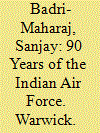

|
|
|
|
|
| Publication |
Warwick, Helion and Company Ltd, 2022.
|
| Description |
70p.pbk
|
| Series |
Asia@War
|
| Standard Number |
9781915070586
|
|
|
|
|
|
|
|
|
|
|
|
Copies: C:1/I:0,R:0,Q:0
Circulation
| Accession# | Call# | Current Location | Status | Policy | Location |
| 060246 | 358.40954/BAD 060246 | Main | On Shelf | General | |
|
|
|
|
| 2 |
ID:
131220
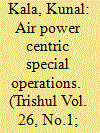

|
|
|
| 3 |
ID:
155037
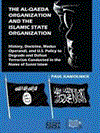

|
|
|
|
|
| Publication |
New Delhi, Alpha Editions, 2017.
|
| Description |
xxiii, 334p.hbk
|
| Standard Number |
9789386686916
|
|
|
|
|
|
|
|
|
|
|
|
Copies: C:1/I:0,R:0,Q:0
Circulation
| Accession# | Call# | Current Location | Status | Policy | Location |
| 059192 | 303.625/KAM 059192 | Main | On Shelf | General | |
|
|
|
|
| 4 |
ID:
154380
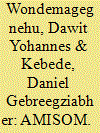

|
|
|
|
|
| Summary/Abstract |
The African Union Mission in Somalia (AMISOM) is an atypical peace support operation (PSO) that has evolved sui generis and continues to chart its own trajectory politically and militarily. With a view to contributing to the African Union (AU) Commission’s policymaking process and articulation of its PSO doctrine, this article examines AMISOM’s various distinct features, especially as they relate to the mandating process, mission support arrangements, and interactions with the Somali National Security Forces (SNSF). The article argues that there is a clear need for the AU to articulate a PSO doctrine appropriate to the types of missions which the AU undertakes, both now and in the near future. AMISOM’s initial mandating process was event-driven rather than context-driven, and the mission operated was based on a logistic supply arrangement that was at times not in sync with its overall operational demands. While the mission has multifaceted interactions with the SNSF, the interplay was fragmented, not least due to a multiplicity of actors and interests. A reading of the AMISOM experience underlines that the design of the AU’s contemporary peace missions’ doctrine should be centred on an integrated and mutually-reinforcing relationship among operations, institution-building, logistical support, and politics.
|
|
|
|
|
|
|
|
|
|
|
|
|
|
|
|
| 5 |
ID:
146909
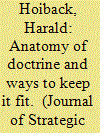

|
|
|
|
|
| Summary/Abstract |
The word ‘doctrine’ has been part of military terminology for more than 100 years. Even though the word is ubiquitous in modern military literature, it is still ambiguous and tends to put very different ideas into readers’ mind. In order to make the concept less vague and thus more useful, this paper explores the historical and pragmatic origin of the concept, and points out some of its potential pitfalls. The main message of the article is that, although it can be extremely hard to make a viable doctrine, it is worth the effort.
|
|
|
|
|
|
|
|
|
|
|
|
|
|
|
|
| 6 |
ID:
160026
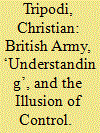

|
|
|
|
|
| Summary/Abstract |
Over the past decade, Western military doctrines concerned with matters of irregular warfare and counterinsurgency have emphasised the requirement for properly ‘understanding’ the social, political and cultural environments in which those militaries may operate; the so-called human and socio-political ‘terrain’. This has led to a number of advancements and initiatives designed to facilitate the way that militaries may enhance that understanding. One of those initiatives has been the emergence from within the British military of a doctrine – JDP 04 ‘Understanding’ – designed for that purpose. Using that doctrine and other subsequent publications as a template, this article will examine the utility of ‘understanding’ for those commanders seeking to match military activities with political ends. It proposes that while any advances in understanding the operating environment are to be applauded, the ‘understanding’ of greatest importance is that relating to the feasibility of the strategic objectives at hand. If those objectives lack inherent feasibility, then the development of subordinate forms of understanding, particularly in relation to the socio-political dynamics of target societies, will likely only serve to slow the process of failure.
|
|
|
|
|
|
|
|
|
|
|
|
|
|
|
|
| 7 |
ID:
186528
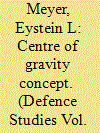

|
|
|
|
|
| Summary/Abstract |
This article applies grounded theory and epistemological, teleological, ontological, and methodological (ETOM) lenses to describe the prevalent contemporary theories of the centre of gravity concept, originated by Carl von Clausewitz. These include the theories of John Warden, Joe Strange & Richard Iron, Antulio Echevarria II, Milan Vego, Dale Eikmeier, and Jacob Barfoed. The article then compares the theories across 14 deduced theoretical aspects and produces a comparison matrix, that can be used as an analytical tool, and discusses implications as guidance for further research and doctrine development. The article argues that the term “centre of gravity” is polluted, and that the application of the term in military planning and doctrines requires careful attention to the specific theory being applied, so that logical consistency and clear, accurate communication is achieved. Alternatively, the concept may be removed from doctrine altogether, renovated with inclusion of a new unpolluted term, or reconstructed with removal of the centre of gravity, leaving a “critical factor analysis” concept behind. This article also provides a level of granularity to the debate about the concept, that renders critics like Paparone & Davis Jr and Zweibelson partly irrelevant and can provide a more nuanced and qualitative basis for future discussion.
|
|
|
|
|
|
|
|
|
|
|
|
|
|
|
|
| 8 |
ID:
128638
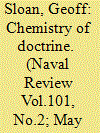

|
|
|
|
|
| Publication |
2013.
|
| Summary/Abstract |
The author, in a three part series examines the evolution of naval warfighting doctrine, with examples, and seeks to set out a grammar of doctrine.
Within the context of the present highly complex and shifting environment and in the face rapid technological change, it is not unreasonable to question the validity of doctrine - Albert Palazzo -2008
Knowing the enemy is the bedrock of the business of strategy: strategic theories in comparison, are second order problems. To concentrate on doctrine before enemies is to put the theoretical cart before the actual horse -a double error - Ken Booth, 1979
Doctrine is the box outside of which we need to think- Colonel Rory Copinger, Symes, Royal Marine-2010
|
|
|
|
|
|
|
|
|
|
|
|
|
|
|
|
| 9 |
ID:
128659
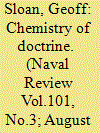

|
|
|
|
|
| Publication |
2013.
|
| Summary/Abstract |
In the second part of his series of articles, the author examines the development of naval doctrine through the 18th century, culminating in the production and publication of the fighting doctrine which informed the first world war, and governed the conduct of the battle of Jutland in 1916
|
|
|
|
|
|
|
|
|
|
|
|
|
|
|
|
| 10 |
ID:
128720
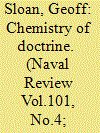

|
|
|
|
|
| Publication |
2013.
|
| Summary/Abstract |
In this the concluding part of his series on the chemistry of doctrine, the author examines the further evolution of naval doctrine during the second world war, with specific reference to the battle of Atlantic . He concludes by surveying the whole three part series and drawing some enduring lessons and principles.
|
|
|
|
|
|
|
|
|
|
|
|
|
|
|
|
| 11 |
ID:
143634
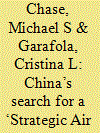

|
|
|
|
|
| Summary/Abstract |
Once dismissed by many outside observers, the Chinese People’s Liberation Army Air Force (PLAAF) has undergone an impressive transformation over the past two decades, emerging as one of the world’s premier air forces. As it continues to modernize, it is focused on becoming a ‘strategic air force.’ PLAAF strategists suggest this means it should play a decisive role in protecting Chinese national interests, field modern capabilities commensurate with China’s standing as a major power, and enjoy the institutional status befitting its role as a ‘strategic service,’ an important consideration given the historical dominance of the ground force in China’s military.
|
|
|
|
|
|
|
|
|
|
|
|
|
|
|
|
| 12 |
ID:
130689
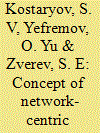

|
|
|
|
|
| Publication |
2014.
|
| Summary/Abstract |
The article discusses the U.S. commands' views on the significance of human factor in the battlefield as set out in the Joint Vision 2020 doctrine. Topics discussed include the high value on information in U.S. documents on military policy and warfare, role of high-tech weapons and information systems in military conflicts and the imperfections of technology. It also mentions the importance of effective leadership in contemporary system for educating and training of U.S. servicemen
|
|
|
|
|
|
|
|
|
|
|
|
|
|
|
|
| 13 |
ID:
131466
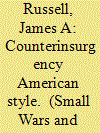

|
|
|
|
|
| Publication |
2014.
|
| Summary/Abstract |
This article examines the complex legacy of David Petraeus who was a key figure in the emergence of the US military shift towards counterinsurgency doctrine in the years after 2006. Although Petraeus has been perceived by critics as a publicity seeker, he can be credited with laying the foundations for a more serious commitment to COIN involving in particular in integrating conventional and Special Forces in arenas like village stability operations. The article looks a Petraeus's role in both Iraq and Afghanistan: it concludes that, in the case of Afghanistan, it is too early to assess whether counterinsurgency has had a decisive impact of the outcome of the war against the Taliban.
|
|
|
|
|
|
|
|
|
|
|
|
|
|
|
|
| 14 |
ID:
145857
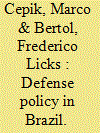

|
|
|
|
|
| Summary/Abstract |
This article aims to analyze the Brazilian Defense Policy in terms of its ability to reduce the gap between ends and means. Since 2003, the Brazilian defense policy has evolved along with Brazil’s increased role in the international system. Sustaining this process depends on institutional, economic, and operational conditions that are yet to be fully guaranteed. They require negotiations, reforms, and strategic perspective. By identifying specific challenges emerging from the national security institutional framework, the combat capability building process, the budgetary cycle, as well as from the defense industrial base, we sought to explain their rationale and to offer concrete policy pointers to overcome obstacles. As a general conclusion, the Brazilian defense policy was strengthened by the 2008 National Defense Strategy (END) due to its clearer strategic goals. Bridging the gap between those ends and the proper means is a continuous effort for any given country, but in the case of Brazil it has been addressed with firmer steps since the END, even in the face of harder economic and political conditions.
|
|
|
|
|
|
|
|
|
|
|
|
|
|
|
|
| 15 |
ID:
146915
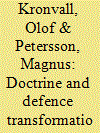

|
|
|
|
|
| Summary/Abstract |
In this article we analyse to what degree the three functions of doctrine proposed by Harald Høiback – doctrine as a tool of operations, a tool of education, and a tool of change – have driven defence transformation in two Scandinavian states, Norway and Sweden. We conclude that doctrine, both allied and national, has had some impact on defence transformation in both countries: through the operations in Afghanistan, through education both at the branch level and joint level, and through organizational adaption to (first) the US ‘RMA paradigm’ and (later) to the subsequent ‘COIN paradigm’. However, other factors, such as threat perception and defence spending, have also played an important role. It also remains to be seen whether the changes are ephemeral or of a more permanent nature.
|
|
|
|
|
|
|
|
|
|
|
|
|
|
|
|
| 16 |
ID:
086166
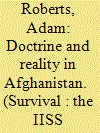

|
|
|
|
|
| Publication |
2009.
|
| Summary/Abstract |
The limitations of military doctrines and practice are often exposed, not by arguments, but by events. Thus it was mainly events in Iraq and Afghanistan that exposed the inadequacies of the so-called 'revolution in military affairs' - an idea that was popular in the United States from the mid 1990s until at least 2003. Now, Afghanistan - and the situation in Pakistan with which it is inextricably linked - is proving to be a harsh test of the revived ideas of counter-insurgency.
Afghanistan was always likely to be a difficult theatre of operations for outside military forces. Seeing this (and perhaps also because he did not want an ongoing distraction from the future invasion of Iraq, for which he was already lobbying), then-US Deputy Secretary of Defense Paul Wolfowitz said in November 2001:
In fact, one of the lessons of Afghanistan's history, which we've tried to apply in this campaign, is if you're a foreigner, try not to go in. If you go in, don't stay too long, because they don't tend to like any foreigners who stay too long.
|
|
|
|
|
|
|
|
|
|
|
|
|
|
|
|
| 17 |
ID:
162758
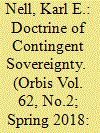

|
|
|
|
|
| Summary/Abstract |
Disengagement of U.S. leadership in recent years has not only emboldened the world's worst actors, it has enabled the emergence of non-state groups such as the Islamic State of Iraq and al-Sham (ISIS) to threaten a new and ominous trend in international affairs—the pursuit of sovereign authority by transnational violent-extremists. Amending both the Clausewitzian “remarkable trinity” to explicitly encompass non-state actors in war and the balance-of-power praxis of Talleyrand to one favoring dynamic repair of failed and failing states in diplomacy, the Doctrine of Contingent Sovereignty proposed in this article provides the requisite tools for bolstering legitimacy of weakened states while simultaneously affording the necessary freedom-of-action for the United States to secure its vital national interests. Analogous to the Monroe Doctrine of the nineteenth-century, which put putative expansionist powers on notice, this new doctrine asserts that the privilege of sovereignty remains contingent upon adherence to accepted international norms of behavior.
|
|
|
|
|
|
|
|
|
|
|
|
|
|
|
|
| 18 |
ID:
146670
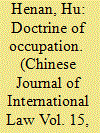

|
|
|
|
|
| Contents |
In contemporary international law, the doctrine of occupation has two aspects: 1) the subject of occupation, i.e. sovereign State; 2) the object of occupation, i.e. terra nullius (land without sovereignty).1 Meanwhile, this doctrine is seen as an analogy from the Roman law of occupatio. Given that international legal theory has transformed through three stages of development from jus gentium in antiquity, to natural law theory in the early modern period to positivism in the nineteenth century, this article aims to examine whether the historical and contemporary meaning(s) of this doctrine have kept validity throughout such paradigm shifts. In particular, contemporary international law pays little attention to the legal status of this doctrine in the natural law tradition. This article finds that the doctrine of occupation has a legal foundation in natural law theory in which this doctrine was seen as applicable to individuals rather than the State and terra nullius was seen as land without private property while sovereignty was only secondarily related to occupation as a result of civil and political developments to establish a public authority within the occupied land. European colonial practices of this doctrine from the sixteenth to the early nineteenth century were consistent with the natural law tradition. Therefore, international legal positivism fails to provide validity to the contemporary meaning of this doctrine under its own theoretical framework.
|
|
|
|
|
|
|
|
|
|
|
|
|
|
|
|
| 19 |
ID:
185150
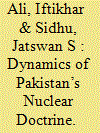

|
|
|
|
|
| Summary/Abstract |
This article seeks to discuss Pakistan’s nuclear doctrine and its significance for strategic stability in South Asia which is challenged by complex interactions between different players in political, military, and technological dynamics. In particular, India’s easy access to technology and the challenges for Pakistan associated with fears of low-intensity conflicts due to Indian offensive strategies have resulted in dangerous instabilities. The Indian technological advancement has inevitably brought revolutionary changes in the strategic thought process thus continuously forcing Pakistan to modify or upgrade its nuclear doctrine. We argue that Pakistan’s nuclear doctrine is ambiguous, and the changing contours of Pakistan’s nuclear doctrine are within the framework of how technological advancement navigates strategic stability in the South Asian region.
|
|
|
|
|
|
|
|
|
|
|
|
|
|
|
|
| 20 |
ID:
115454
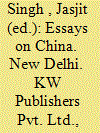

|
|
|
|
|
| Publication |
New Delhi, KW Publishers Pvt. Ltd., 2012.
|
| Description |
vii,304p.
|
| Standard Number |
9789381904237
|
|
|
|
|
|
|
|
|
|
|
|
Copies: C:1/I:0,R:0,Q:0
Circulation
| Accession# | Call# | Current Location | Status | Policy | Location |
| 056850 | 327.51/SIN 056850 | Main | On Shelf | General | |
|
|
|
|
|
|
|
|
|